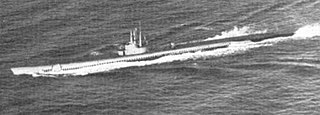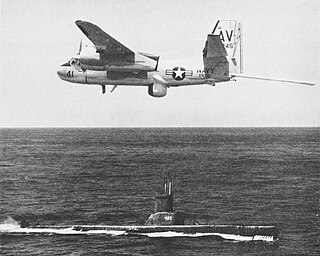
USS Argonaut (SS-475) was a Tench-class submarine operated by the United States Navy (USN). Constructed at Portsmouth Navy Yard during the second half of 1944, Argonaut was commissioned into the USN in 1945 and operated during the final year of World War II, although her only contact with the Japanese was when she sank a junk in August. During the 1950s, the submarine was modified for greater underwater endurance, and to guide the Regulus I missile. From 1963 to 1965, Argonaut operated in the Mediterranean Sea.

USS Runner (SS/AGSS-476), a Tench-class submarine, was the second ship of the United States Navy to be named for the runner, an amberfish inhabiting subtropical waters.

USS Grenadier (SS-525), a Tench-class submarine, was the second ship of the United States Navy to be named for the grenadier, a soft-finned deep sea fish of the Macrouridae with a long, tapering body and short, pointed tail family, also known as rattails.

USS Picuda (SS-382), a Balao-class submarine, was originally named Obispo, making her the only ship of the United States Navy to be named for the obispo, a spotted sting ray.

USS Cutlass (SS-478), a Tench-class submarine, was the only ship of the United States Navy to be named for the cutlassfish, a long, thin fish found widely along the coasts of the United States and in the West Indies. Her keel was laid down by the Portsmouth Navy Yard on 10 July 1944. She was launched on 5 November 1944 sponsored by Mrs. R. E. Kintner, and commissioned on 17 March 1945 with Commander Herbert L. Jukes in command.

USS Remora (SS-487), a Tench-class submarine, was the only ship of the United States Navy to be named for the remora, a fish with a suctorial disk on its head enabling it to cling to other fish and to ships.

USS Sirago (SS-485), a Tench-class submarine, was named for the sirago, a small, freshwater tropical fish.

USS Odax (SS-484), a Tench-class submarine, was the only ship of the United States Navy to be named for odax, a brilliantly colored, red and green fish belonging to the family Scaridae, the parrot fishes.

USS Sea Leopard (SS-483), a Tench-class submarine, was the only ship of the United States Navy to be named for the leopard seal. Her keel was laid down by the Portsmouth Navy Yard on 7 November 1944. She was launched on 2 March 1945 sponsored by Hon. Margaret Chase Smith, United States Congresswoman from Maine, and commissioned on 11 June 1945 with Commander Robert E. M. Ward in command.

USS Irex (SS-482), a Tench-class submarine, was the only ship of the United States Navy to be named for the irex, one of the oceanic fishes belonging to the family carangidae.

USS Medregal (SS-480/AGSS-480), a Tench-class submarine, was the only ship of the United States Navy to be named for the medregal, a streamlined, fast-swimming, bluish-colored fish of the jack family which abounds in waters of the West Indies and in the Atlantic as far north as the Carolinas.

USS Tusk (SS-426), a Balao-class submarine, was the only ship of the United States Navy to be named for the tusk, an alternate name for the cusk, a large edible saltwater fish related to the cod. Her keel was laid down on 23 August 1943 at Philadelphia by the Cramp Shipbuilding Company. She was launched on 8 July 1945 sponsored by Mrs. Carolyn Park Mills, and commissioned on 11 April 1946 with Commander Raymond A. Moore in command.

USS Trumpetfish (SS-425), a Balao-class submarine, was the only ship of the United States Navy to be named for trumpetfish, any of several fishes so-called for their deep, compressed body and long, tubular snout. Her keel was laid down on 23 August 1943 at Philadelphia by the Cramp Shipbuilding Company. She was launched on 13 May 1945 sponsored by Mrs. Oswald S. Colclough, and commissioned on 29 January 1946 with Lieutenant Commander Raphael C. Benitez in command.

USS Chivo (SS-341), a Balao-class submarine, was a ship of the United States Navy named for the "chivo" or big-scaled goatfish Pseudopenaeus grandisquamis, a fish inhabiting the Pacific Ocean between Panama and Mexico.

USS Cubera (SS-347), a Balao-class submarine, was a ship of the United States Navy named for the cubera, a large fish of the snapper family found in the West Indies.

USS Greenfish (SS-351) was a Balao-class submarine of the United States Navy. It was named for the greenfish.

USS Jallao (SS-368), a Balao-class submarine, was a ship of the United States Navy named for the jallao, a pearl-white haemulonid food fish of the Gulf of Mexico.

USS Sea Owl (SS/AGSS-405), a Balao-class submarine, was a ship of the United States Navy named for the sea owl, a lumpfish of the North Atlantic Ocean.

USS Ronquil (SS-396), a Balao-class submarine, was the only ship of the United States Navy named after the ronquil, a spiny-finned fish found along the northwest coast of North America. It has a single dorsal fin and a large mouth and resembles the tropical jawfish.

USS Tiru (SS-416), a Balao-class submarine, was a vessel of the United States Navy named for the tiru, a member of the lizardfish family.



















